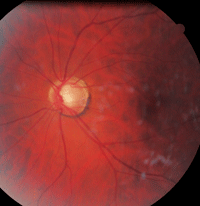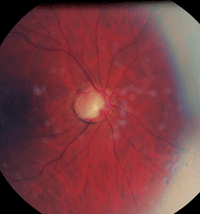 Q: I have a 54-year-old female glaucoma patient who uses Acuvue 2 (Vistakon) contact lenses for continuous wear and instills Combigan (brimonidine tartrate/timolol maleate, Allergan) b.i.d. on top of her lenses. Her cornea exhibits signs of limbal neovascularization, but no toxic staining, and her pressure satisfies her glaucoma specialist. But is it safe for her to instill glaucoma drops on top of contact lenses that she never cleans?
Q: I have a 54-year-old female glaucoma patient who uses Acuvue 2 (Vistakon) contact lenses for continuous wear and instills Combigan (brimonidine tartrate/timolol maleate, Allergan) b.i.d. on top of her lenses. Her cornea exhibits signs of limbal neovascularization, but no toxic staining, and her pressure satisfies her glaucoma specialist. But is it safe for her to instill glaucoma drops on top of contact lenses that she never cleans?
A: The first issue is the patient’s use of low oxygen-transmission hydrogel lenses for “continuous wear… that she never cleans.” The limbal neovascularization shows she clearly is having adverse effects from extended-wear hypoxia. “Either she is wearing her contact lenses for too long a duration, they don’t fit, or perhaps the problem is related to the use of Combigan in conjunction with the contacts,” says George Spaeth, M.D., Louis J. Esposito Research Professor at the Wills Eye Institute in Philadelphia. “At any rate, clearly what’s happening is not good and should be changed.”
Let’s start with the wear schedule and the type of lens the patient is using. Consider refitting the patient into a daily disposable or silicone hydrogel lens that can be worn on a daily basis, suggests Joel A. Silbert, O.D., director of the Cornea & Specialty Contact Lens Service at the Eye Institute at Salus University.


These fundus images show the patient’s glaucomatous optic nerve head, which is more advanced in the right eye. The maculae are flat and healthy.
“If she does so, her corneal health will have received a double benefit,” he says. The lack of staining confirms that her corneal epithelium is in good health, despite the use of Combigan drops.
“Although soft lenses can absorb medications, this type of thin, low-water lens is likely not delivering much to the corneal surface, as tears are likely washing much of it away, which is why we are not seeing signs of corneal toxicity,” Dr. Silbert says. However, systemic absorption can still occur via the conjunctiva and drainage into the puncta.
Researchers have found that removing contact lenses for five minutes during drop instillation allows the most absorption of ophthalmic solution directly to the eye.1 It also lowers the amount of preservatives absorbed by the contact lens. When drops were instilled on top of the contact lens, the BAK concentration was significantly higher than in lenses that were off the eye for five minutes. They concluded that 10-minute lens removal was appropriate to prevent significant BAK uptake and enhance the ophthalmic drug absorption.1
“As long as she is using any drug containing the preservative BAK (as Combigan does)— which is also toxic to corneal epithelium—she should instill her drops prior to lens insertion, and then again approximately 12 hours later, after lenses have been removed,” Dr. Silbert says. Combigan’s prescribing information cautions that soft contact lenses can absorb BAK, causing eye irritation.2 It suggests that patients remove their contact lenses prior to using the drops, wait 15 minutes, then reinsert the lenses.
1. Christensen MT, Barry JR, Turner FD. Five-minute removal of soft lenses prevents most absorption of a topical ophthalmic solution. CLAO J. 1998 Oct;24(4):227-31.
2. Combigan [package insert]. Allergan, Inc., Irvine, CA; 2011.
www.allergan.com/assets/pdf/combigan_pi.pdf. Accessed Sept 20, 2012.

